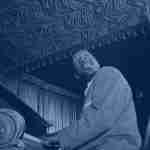Every so often you’ll make a musical discovery that will drastically change the way you approach improvisation. One day you’re struggling over the same tunes, growing more and more frustrated with your own predictable patterns and then it hits you – you discover a secret that was hidden right before your eyes. A subtle mental, aural, or physical shift suddenly happens and you’re able to approach improvisation in an entirely new way – your eyes (and ears) opened to a wealth of new possibilities.
Looking back at my own journey, I’ve made some very important musical discoveries that have changed the way I look at music. Some of these discoveries came rather quickly, with a small amount of practice and others I had to struggle with for years before I had control of them.
But each time the result was the same: from that point on my ears changed. I took on a deeper understanding of the music and more importantly, went into the practice room with a renewed excitement for improvising.
“The real voyage of discovery consists not in seeking new landscapes, but in having new eyes.”~ Marcel Proust
Where I found the information was not important. The true value of these concepts came when I discovered them for myself. When I could hear those lines and harmonies, when I could physically connect them with my instrument, and could feel the time going by as I practiced them.
Only then was I able to fully understand these devices and breakthrough to another level of musical understanding.
Below, I’ve outlined seven harmonic breakthroughs that have changed my approach to improvisation – and will hopefully do the same for you!
Some appear surprisingly simple at first glance, but look a little closer. After further study, it will become clear that these concepts contain deep implications that will affect every aspect of your approach to improvisation.
It doesn’t matter where you get your information or inspiration, the essential element is that you are listening to and transcribing these lines for yourself.
1. Understanding that improvising is more than running scales
One memory I distinctly recall as a beginning improviser, is going to local jam sessions and struggling to play over the various tunes that were called.
During this period my harmonic knowledge consisted of knowing all my major and minor scales, arpeggios, and a few simple licks that I had picked up from some records. Whatever tune was called, I would try to quickly find out the key it was in and then use a corresponding scale to piece together a solo.
On one particular night, a tune was called that had an extended section over a Major 7th chord. Armed with my scales, I did the best that I could over the chord and was immediately followed on stage by a sax player. Over the same section, I heard impressive double-time lines filled with numerous shapes and leaps coming from the bell of that saxophone; lines that seemed impossible with just one scale.
How was this possible with that same major scale that I was using? However, it turns out that there’s more to improvising than scales.
Just like any type of chord, there is a language for playing over Major 7th chords. You can religiously practice your major scales in seconds, thirds, fourths, fifths, in every mode, arpeggiated up and down, down and up, etc. But, despite all of your effort, you’re still not going to be playing logical lines and language – you’ll be playing practice exercises.
This was the tough lesson that I learned that day. Instead of focusing exclusively on scales to conquer any chord, I now realized that I should focus on gathering language from my favorite records.
As soon as I started checking out records and transcribing some of my heroes, I quickly realized that there was a lot more going on than simple chord/scale theory. I stumbled upon enclosures, chromaticism, scales with added notes (e.g. major scale w/ b6th), and other devices that just didn’t line up with the theory I was seeing in books.
Check out Clifford Brown’s solo on the video below as an example of this concept. Listen especially close to what Clifford plays on the solo break and how he deals with the Major 7 chord at the top of the form every time around. He creates beautiful lines, but does so without limiting himself to scales and arpeggios. (This is one solo that I would definitely slow down in Transcribe in order to hear all the notes.)
The clip above is a great example of how to use enclosures and chromaticism within a chord to emphasize strong chord tones; and this concept can be applied to any chord, not just Major 7th chords. Remember, you don’t have to learn the examples that people give you. Find your favorite players and figure out what they are doing over the chords that you’re having trouble with, then transcribe those lines and study them.
2. Navigating static Dominant 7th chords
The way dominant 7th chords are taught in traditional music theory is that their most important function is as a bridge to the I chord: V7 always resolves to I. However, what happens when that V7 doesn’t resolve to I?
In jazz, the V7 chord frequently serves as the I chord, just take a look at the first bar of a blues. In numerous cases, we see V7 chords that are used for an extended period of time and do not resolve right away. This can be a problem when you’re used to that V7 being an inconspicuous chord that promptly resolves to the tonic.
As I was learning to improvise, I consulted my theory books and saw that I could use bebop, diminished, or even altered scales over V7 chords. However, when I tried to use these scales over those extended V7’s, they just didn’t sound right. So where did I go wrong?
Well, because there is a vital difference between V7 chords that appear in a ii-V7-I progression and V7 chords that stand on their own and don’t resolve. The tension that you create over a V7-I with an altered or diminished scale sounds logical as it resolves to the I chord, but when you aren’t resolving to the tonic, this harmonic tension can sound awkward and just plain wrong.
So how are you supposed to play over those puzzling static V7 chords that don’t resolve directly to the tonic? Just like the Major 7th chord above, there is a language over V7 chords that you need to learn from the masters.
Check out what the masters are doing over the first six bars of a blues or the bridge to rhythm changes. One tune that we’ve all probably encountered in learning this music is the tune All Blues. Even though it is so commonly played, it’s a surprisingly challenging tune: a blues in G, in an odd meter that doesn’t follow conventional blues changes. The first time I encountered this tune, I was perplexed at how to create lines over these stretches of V7 chords.
Listen to how Miles, Wayne, and Herbie play over these V7 sounds:
As you study V7 sounds more closely, it will be come apparent that great improvisers aren’t just thinking about that dominant chord the whole time. Many players use the bebop reharmonization technique of implying a ii-V7 over the static V7 chord (D-7 G7 instead of G7). For example, listen to how Freddie Hubbard and Herbie play over these static V7sus chords on One Finger Snap:
3. Understanding the Blues form
Before I figured out what a 12 bar blues was, the term “blues” was pretty abstract for me. It meant that someone was playing a lot of flat thirds or sevenths on a major chord and for some reason or other, they were sad about something.
When I finally understood the form of the blues it was an enormous step and insight into the inner-workings of jazz. Now I knew what everybody was talking about when they said “blues heads.” Before I knew it, I was hearing the 12 bar blues everywhere; on records, at concerts, and at jam sessions.
When people say “It’s all in the blues” they aren’t kidding. If you can sound good on the blues in all keys and can actually say something in your solo, you can play over pretty much anything. Within the blues are major ii-V’s, minor ii-V’s, turnarounds, extended V7 chords, diminished chords, and infinite options for substitution. It’s like everything you need to know about jazz is wrapped up in a neat little 12 bar package.
The big step for me came in many parts when dealing with the blues: learning to navigate those V7 chords, connecting the I chord to the IV7 chord, understanding the different variations of the 12 bar blues, and most importantly learning to make statements and develop ideas through each succeeding chorus.
Spend some quality time with the blues in all 12 keys and your overall level of improvising will noticeably improve. Take a listen to Dexter over the blues to get some ideas flowing:
4. Conquering ii-V7-I’s
They’re in every standard, every blues, every rhythm changes tune, you can even insert them into a chord progression where you see fit. Yes, ii-V’s are everywhere in the jazz repertoire and by learning to successfully navigate this ever present progression, you can transform the way you improvise.
In schools, ii-V’s are taught in the same format: first you learn the function of each chord (the supertonic leads to the dominant and resolves to the tonic) and then you study the relationship and voice leading between the chords (7-3 resolutions between ii-V7 and V7-I). This is important to understand, but it only accounts for a mental understanding of this essential progression.
What you need to do to truly understand this progression is to hear the chords actually progressing from one to the next. I didn’t completely understand ii-V’s until I transcribed a line for myself and learned it in all 12 keys. With this line I could finally hear with my own ears the tonal pull of the progression and the 7-3 resolutions that I had learned about in school.
The ii-V7-I progression is something that you’ll always be working on as long as you are striving to improve as an improviser. You can always transcribe a new line or incorporate a new harmonic idea into this tired and true progression. Aim to gather ten ii-V lines from your favorite records as a start.
John Coltrane may be remembered most for his “sheets of sound” and his landmark records like A Love Supreme, but before he was pushing the envelope in jazz, he was playing the hell out of ii-V’s. Listen to and study the clip below of Trane’s solo on Moment’s Notice. Pay close attention to how he navigates the numerous ii-V’s in the first eight bars of the form:
5. Turnarounds and rhythm changes
After you learn to play over ii-V’s, tackling rhythm changes is the next logical step. Once you see how to connect the ii to the V7 chord, doing the same with the iii-VI7 chord is simple. Eventually, I realized that a turnaround was essentially two ii-V7’s put together and this made the progression much easier to play over.
Using the same techniques that I employed over ii-V7’s, I began to see this progression pop up in countless standards. The trap here was to avoid sounding repetitive with this all too common progression, especially when it came to playing over rhythm changes.
Again, strive to find ten lines to play over this sequence. Don’t get caught with just one line the next time you solo over rhythm changes. Moreover, don’t feel like you have to play every chord in the progression every time you play a turnaround. If you listen to the greats, they often play over the I chord for the entire sequence.
For example, listen to how Miles, Sonny Rollins, and Monk play over the A section to Oleo. On some choruses they’re clearly outlining each chord of the progression and on others they are playing over just the tonic.
6. Altering V7 chords
The V7 chord is one of the most versatile chords that we can improvise over. On top of this sound you can imply a number of different harmonies that vary in their level of dissonance.
At a certain point in my development, I became extremely bored with the way I way playing on V7 sounds. I had my b9’s and #9’s and altered scales, but it just seemed like there was nothing new to play. Little did I know that this couldn’t be further from the truth. The V7 chord can take anything that you can throw at it harmonically.
Try taking a triadic approach for instance. Over a C7 chord, explore playing a C Maj. triad and a Bb Maj. triad. How about a C Maj. triad and a D Maj. triad, implying a V7#11 sound. Explore the possibilities of using a diminished sound, major triads separated by minor thirds ( C, Eb, F#, and A over C7). These are just a few ideas revolving around the use of triads.
A great way to practice this is to go to the piano and try out different sounds over a V7 chord. Be as creative as you can and test the tolerance of your ear. With this in mind, take a listen to the video below of Mulgrew Miller playing over Woody ‘n You and study how he alters the various V7 chords throughout the tune:
7. Implying unrelated tonalities
After awhile, you’ll come to the realization that you can imply any number of harmonies over a certain chord or progression. Over V7 chords you can play Major 7th’s, you can play minor 3rd’s on a Major 7th chord, you can play E Major over F Major, and a multitude of other dissonant combinations.
The trick however, is to play these outside harmonies as you would well placed lines, not by forcing unrelated scales and triads over standard progressions. This is a process that takes time and some trial and error in the practice room, but when you’re stuck in a harmonic dead-end, this concept can give you unlimited possibilities.
Check out the clip below of Michael Brecker playing over Blue Bossa. As you can immediately hear, he has such control of the instrument and harmony that he can literally play anything he wants over any chord:










